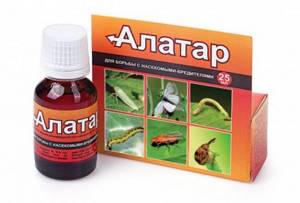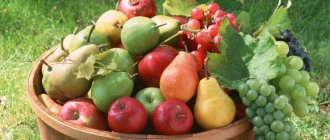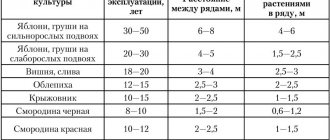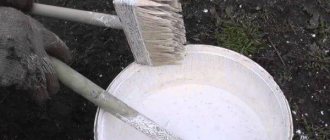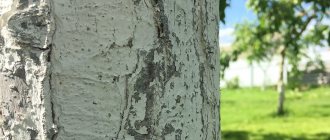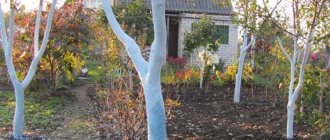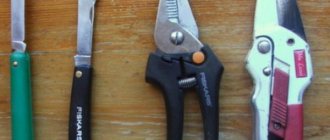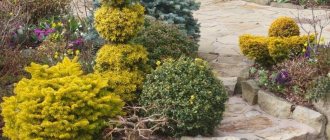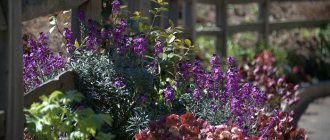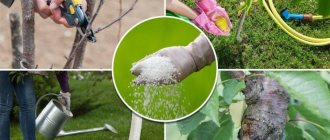Category: Plant protection Reading time: 8 min · Views: 483
With the onset of autumn, the work of gardeners does not decrease. It is at this moment that most of the time must be devoted to treating plants and fruit trees from pests and all kinds of diseases. Treating trees in the fall will help them survive severe winter frosts and protect them from insects and parasites.
Do I need to spray fruit trees in the fall?
Along with the trees, numerous garden pests are also preparing for winter. Some of them overwinter in fallen leaves, others choose damage and folds of bark as shelter. Many burrow into the soil, overwintering directly in the tree trunks. Autumn work on cleaning and cultivating the garden can significantly reduce this pest population, so it is imperative to carry it out.
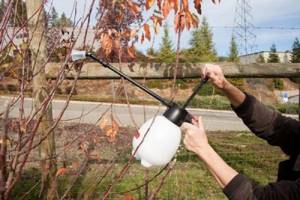
Spraying with fungicides also plays an important role in disease prevention. Pathogens and fungal spores are constantly present on the tree bark, and autumn treatment very effectively prevents their development.
Goals and objectives of autumn processing of fruit trees
The main task of processing fruit trees in the autumn is to prepare them for winter. In addition, the following tasks are solved:
- Destruction of pests overwintering on the trunk and branches.
- Destruction of insects and their larvae overwintering in the soil around the tree trunk.
- Fighting manifestations of rot and fungal infections.
- Cleaning wood from moss, lichens, plaque.
Mechanical and biological methods
Plant pests multiply very quickly, attacking fruit and vegetable crops. If there are still a few of them in the garden, you can act without the use of poisons:
- Collection by hand. The method is effective in controlling aphids and other garden pests if several individuals are found on the foliage. You can collect insects or pick off the foliage on which they live. Leaves are immediately destroyed or burned.
- Attracting other insects and birds that feed on parasites. For example, ladybugs and lacewings are effective against aphids. This method is suitable in the initial stages of infection or as a preventative measure.
- Destruction of anthills. They breed pests to feed on their secretions. By destroying anthills, you can reduce the parasite population.
Read more: How to drive away ants forever
- Planting plants with repellent scents. Marigolds, mint, dill, and garlic repel pests of fruit crops with their pungent odor.
- Irrigation with water. Direct a stream of water from a hose onto the affected plants. It washes the insects to the ground, where they are eaten by birds. Regular treatment of plants with water will help get rid of parasites.
Related article:
Pharmacy products that can be used to protect your garden

Mechanical and biological methods do not work if there are a lot of pests and they have infected most of the plantings. In this case, more radical measures will be required.
Preparing for autumn gardening
The optimal time for cultivating the garden is the second half of October, and if the autumn is long enough and warm enough, then the beginning of November, even if frosts have already occurred by this time. The foliage, as a rule, is already flying away, so nothing will interfere with high-quality spraying. It is best to choose a clear day without precipitation for this procedure.
Before spraying trees, you need to carry out sanitary pruning and completely clear the tree trunks of fallen leaves. It is also necessary to stock up on a sufficient amount of solution for the work, rinse and test the sprayer, and also stock up on personal protective equipment. Since many solutions are toxic, you will need eye (special goggles), breathing (respirator) and hand skin (rubber gloves) protection.
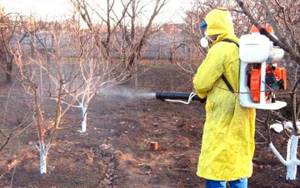
To treat small trees, you can use a hand sprayer or spray bottle. For larger ones, it is better to use a backpack sprayer, and treat the upper tier of the crown from a stepladder.
Safety regulations
Before spraying, wear protective clothing, goggles and gloves. Wear a respirator mask. Do not eat or smoke while processing trees.
When carrying out work, take into account the direction of the wind so as not to get caught in the flow of drugs.
After carrying out work, wash your hands and face with soap, wash your clothes, and clean your shoes.
Conclusion. You learned how to spray trees in the fall, what preparations can be used, and what to pay attention to.
Follow the safety tips and be aware of the timing of the operation. And in conclusion, a video where an experienced gardener tells how to spray the garden in the fall:
Ukrainian
Preparations for spraying fruit trees
There are quite a few different drugs that are used to treat fruit trees against pests and diseases. These include the following:
- carbamide (urea) solution;
- Bordeaux mixture;
- copper sulfate solution;
- iron sulfate solution;
- mineral fertilizer solution;
- other fungicides and insecticides.
Spraying fruit trees with urea in autumn
Urea (urea) is a fairly common water-soluble ammonia fertilizer. To prepare a solution for spraying, you need to dilute 0.4-0.5 kg of the substance in a bucket of water (10 l). Spraying with urea is effective against scab pathogens. In addition to the sanitary purpose, such a solution acts as a foliar feeding, thereby increasing the winter hardiness of plants.

Tree trunk circles are also treated with a solution of high concentration (7-8%), destroying pests overwintering there. However, you need to make sure that such a solution does not get on the tree bark, otherwise the plant will receive a chemical burn.
Autumn spraying of fruit trees with iron sulfate
Iron sulfate is widely used in gardening as a means of combating and preventing diseases such as scab, powdery mildew, fruit rot (monoliosis), black cancer and others. It is also a very effective remedy against various mosses and lichens that parasitize the bark of fruit trees. Iron sulfate is a water-soluble compound. To prepare the solution, you need to take 200-300 g of the product per 1 bucket of water; if the trees suffered from any disease during the season, the proportion of vitriol can be increased to 400 g.
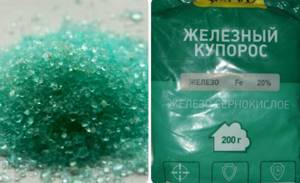
Treating trees with copper sulfate
Preparations containing copper have long been successfully used to protect plants by gardeners around the world. One of these products is copper sulfate, a widely known substance used both as a microfertilizer and as a broad-spectrum fungicide (antifungal agent). It is used for the prevention and treatment of the same diseases as iron sulfate, but it is ineffective in the fight against moss and lichens.

To prepare a solution for spraying, mix 100 g of copper sulfate and 10 liters of water. If diseases were noted on the plants during the season, then you need to take 300 g of vitriol. The substance dissolves well in water, giving it a characteristic blue color.
Other preparations for processing fruit crops
In addition to urea, copper and iron sulfate in their pure form, their combinations with each other are also used. For example, a good result is obtained by using iron sulfate mixed with urea (200 g of each drug per 1 bucket of water). However, you should not mix copper and iron sulfate; it is better to spray with these preparations at different times of the year. For example, treat the garden with iron sulfate in the fall, and copper sulfate in the spring.
There are other preparations that can be used in the fall to spray fruit trees against diseases. These include the well-known Bordeaux mixture, which is copper sulfate in combination with quicklime. Ready-to-use powder can be purchased in stores, however, if necessary, it is not difficult to make it yourself. To prepare a 3% solution of Bordeaux mixture you will need:
- copper sulfate – 300 g;
- quicklime – 400 g.
Each component is dissolved in 5 liters of water. Then the copper sulfate solution is carefully added to the lime solution, taking precautions and stirring constantly.
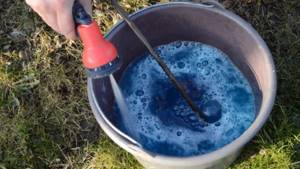
If fruit and berry trees have not been sick during the year, the concentration of the solution can be reduced to 1%. To do this, you will need to reduce the content of all ingredients by 3 times. The procedure for preparing Bordeaux mixture remains unchanged.
For autumn treatment of the garden against pests, you can also use insecticides, for example, Fufanon or Preparation 30 Plus. These are quite effective means, but only autumn treatment will not give the desired result. For maximum effect, spraying against pests with such means is carried out twice, in early spring and late autumn.
LiveInternetLiveInternet
Quote from natalca
Read in full In your quotation book or community!
When and with what to spray fruit trees in the fall before wintering
With what and when to spray fruit trees in the garden in the fall ? Quite often the reader asks this question.
In order for the wintering of trees to be successful, the gardener will need to protect his fruit trees from pests and diseases. By spraying trees in the fall, you will ensure that they look healthy and bloom throughout the next season.
Autumn spraying of trees is an important factor in garden care. Treatment of fruit trees is carried out using sprayers, while observing all safety rules, since later spraying is carried out with pesticides. In view of this, each gardener needs to have a set of clothes to carry out this procedure: gloves, a protective gown and, of course, a respirator. The preparation for spraying fruit trees in the fall should be selected based on existing diseases and pests, and whether this treatment is early or late. Since late autumn is usually rainy, it is necessary to wait for dry weather; in no case do not spray the plantings before the rain, otherwise the rain will wash away the substance and the garden will remain unprotected or will not have sufficient effect. The weather should be dry and windless.
Spraying of trees in late autumn is carried out just before the onset of winter. Of course, if there are plantings in the garden that are diseased, the procedure is carried out outside the schedule.
With the onset of early autumn, the garden especially needs care and attention. To ensure that fruit trees are resistant to winter and cold, when sprayed in late November, they are also fertilized with potassium and phosphorus fertilizers.
For autumn spraying of fruit trees, it is good to use a urea solution, with the calculation: 500-700 grams of urea per 10 liters of water. Interestingly, when spraying, you need to treat both the tree itself and the area underneath it so that the entire infection is killed. The spray should be dusty and fine. This procedure will reduce the risk of garden disease next year.
However, many gardeners are in a hurry and make a serious mistake by cultivating their garden in early autumn, when the trees have not yet lost all their leaves. Spraying the garden with such a solution can only cause burns and untimely leaf fall. In this case, no effect will be achieved. As a result, the gardener will receive a weakened garden with a lack of useful nutrients, which will hardly be able to survive the winter. It is much more prudent to use a solution of this concentration in late autumn - in November.
In mid-autumn, in October, the bases of the branches and trunks must be whitened with lime mortar, having first cleared them of dead bark. As for young plantings, they are covered with a chalk solution. Apple and pear trees are protected from rodent invasion by tying the trunks and bases of skeletal branches. You can tie fruit trees with matting or burlap using young cherry or walnut branches. Some people use stockings.
Preparations for spraying trees.
Iron sulfate is used for spraying plants and the soil under them before the beginning of the growing season or in the fall after the leaves fall, in order to combat diseases of pome and stone fruit crops and berries (diseases of the trunk and branches, moniliosis, scab and other spots), grapes (anthracnose, bacterial cancer, spotty necrosis, mildew).
Urea is an effective measure for the destruction of leaf roller caterpillars, aphids, honey beetles and apple blossom beetles. The effect of nitrogen spraying lasts about 2 weeks, so as time passes, it is recommended to repeat the spraying procedure.
Autumn treatment with a nitrogen solution should also involve some kind of fungicide and include spraying not only the trees themselves, but also the soil under them. Fallen leaves must be subject to mandatory treatment if they are not planned to be removed.
with urea both in spring and autumn. Only in the fall it is important not to rush. If we start doing this before the trees have lost all their leaves, we risk slowing their growth, making them more likely to freeze in the winter. The concentration - 700 grams of substance per 10 liters of water - is optimal for both spring and autumn spraying. Spraying with urea will protect trees from aphids.
Spraying trees with diesel fuel helps to achieve complete destruction of the larvae due to the fact that the solution sprayed over the surface of the bark forms a uniform oily film on the surface of the branches and poles, which does not allow the larvae to breathe, as a result of which they suffocate as soon as possible after treatment.
Since this petroleum product is not a fungicide, it can be sprayed not only at the beginning of spring and late autumn, but also throughout the entire flowering period of the fruit tree. Typically, it is diluted according to one of the following recipes:
- To 10 parts of water add 1 part of iron sulfate, then 10 parts of 10% milk of lime and only then 20 parts of diesel fuel. The resulting mixture will have a 50% concentration and is recommended for use before bud formation and after leaf fall.
- 5 parts clay and 5 parts water are mixed with 20 parts fuel. The resulting solution has the same concentration as the previous one, but does not contain a fungicide and can be used during the period of fruit appearance.
- Another option for obtaining a 50% solution for spraying is to mix 9 parts of water with 1 part of laundry soap and 10 parts of diesel fuel.
The article uses materials from the site https://www.soweren.ru
Series of messages “Pest Control”:
Part 1 - How will copper sulfate help? Part 2 - Tips from experienced people against pests... Part 43 - Traditional methods of controlling aphids. Part 44 - An easy way to get rid of weeds Part 45 - When and with what to spray fruit trees in the fall before wintering Part 46 - WHAT FLOWERS AND HERBS CAN REMOVE ANTS AND APHIES? Part 47 - How to kill weeds without herbicides
How to treat fruit trees in the fall
Summarizing the above, we can conclude: it is necessary to treat fruit trees in the fall. You can use a variety of formulations as spraying agents, buying ready-made mixtures and preparations in stores or making them yourself.
Processing of fruit trees: table and timing
To treat your garden in the fall, you can use any of the preparations presented below.
| Name of the drug | Purpose | Processing times |
| Bordeaux mixture1% or 3% | Complex preparation for putrefactive, fungal and other diseases | After the leaves fall, before frost sets in |
| inkstone | Destruction of mosses and lichens | -//- |
| Copper sulfate | Prevention of scab, coccomycosis, rot, spotting, clasterosporosis | -//- |
| Urea | Destruction of insect pest larvae | -//- |
| Preparations Skor + Karbofos (Skor + Bison) | An aqueous solution of a mixture of drugs is effective against both insect larvae and diseases | -//- |
How to treat fruit trees against pests in the fall
The most popular means for treating fruit trees against pests in the fall is urea. It is effective against leaf roller larvae, weevils, and also against scab pathogens. The crown is treated with an aqueous solution of 4-5% concentration; to treat the tree trunk circles, the urea content must be increased to 8%.
How to treat fruit trees against diseases in the fall
The following preparations can be used to treat fruit trees against diseases in the fall:
| Name | Concentration | Purpose |
| Copper sulfate 1 or 3% | 100 or 300 g of substance per 10 liters of water | For the prevention and destruction of spotting, monoliosis, coccomycosis, etc. |
| Iron sulfate 2 or 4% | 200 or 400 g of substance per 10 liters of water | Destruction of mosses, lichens, prevention of powdery mildew, monoliosis, rot. |
| Bordeaux mixture 3% | 300 g copper sulfate + 400 g quicklime per 10 liters of water | Against scab, gray rot, coccomycosis, etc. |
Why do you need to treat plants in the garden?
Breeders have created some varieties and hybrids of fruit trees and berry trees that are resistant to pests and diseases, but there are still no crops that are absolutely immune to parasites and fungi. Therefore, gardeners stop the invasion of harmful voracious insects and diseases with a number of measures, including spraying fruit trees and shrubs in spring and autumn.
Note! Processing plants in the garden is not a strictly regulated activity, since no one knows in advance what preparations are needed for such work. There is no need to draw up a strict treatment schedule; the degree of infestation of the garden with insects and diseases is taken into account here.
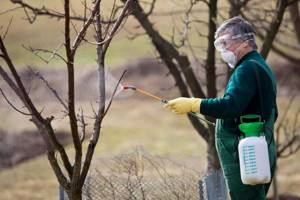
Just in case, do not treat plants with chemicals - they can cause harm. That is, you cannot use chemicals unnecessarily, since each living plant has its own unique characteristics, immunity and well-being. Chemicals in excess also affect the well-being of people and the environment as a whole.
How to spray trees correctly
An important condition for starting work on spraying garden plantings in the fall is the absence of foliage. The falling of leaves serves as a kind of signal that the tree has entered hibernation mode. Treatment should be done before frost, on a dry, windless day. This will facilitate better absorption of fungicides into the bark. Before spraying, you need to clean the bark of the trees and prune them, if so provided for in the plan. The tree trunk circles must be completely cleared of fallen leaves.
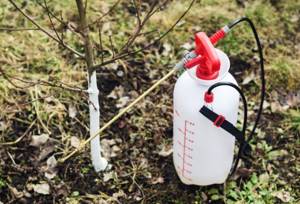
The treatment of each tree should begin from the highest point of the crown, sequentially going around it in a circle and spraying all tiers of the plant from top to bottom. To do this, it is convenient to use a sprayer on a long rod. Dwarf, columnar and young trees can be sprayed using a small hand sprayer or spray bottle. After finishing work with the crown, treat the tree trunk circles, increasing the concentration of the active substance. For this procedure, you can use a regular watering can.
When is spring treatment of plants carried out?
Spraying of fruit trees in spring should be carried out:
- before the onset of sap flow (vegetation);
- along the green cone of the kidneys;
- during the flowering period;
- upon completion of flowering.
It is important to know! It is necessary to focus on dry sunny weather and above-zero night temperatures. During precipitation, high humidity, fog, and temperature changes, the effect of treating plants against insects and fungi will be reduced.

So, when to spray trees in the spring.
First spraying
When the buds are still dormant and not swollen, and the branches are still “bare”, the first treatment of the plants is carried out. If insects do not yet manifest themselves during this period, then fungal spores are already scattered throughout the garden. Stone fruits especially suffer from moniliosis. On cherries, cherries, plums and peaches it is recognized by monilial burn - withered brown tips of branches. Pome crops: apple and pear trees, quince are affected by scab spores. It reproduces on wilted fruits and leaves that remain on trees after harvesting in the fall. Spores are stored under the bark and in fallen leaves. Coccomycosis, leaf spot, moss and lichen, aphids, mites, apple moth caterpillars, copperhead, etc. may also appear.
Health-improving and preventive measures begin in the first ten days of March when a stable temperature of 5°C is established. The snow will have melted by this time. The following work needs to be done:
- trim and clean trees and shrubs;
- process trunks;
- carry out spraying.
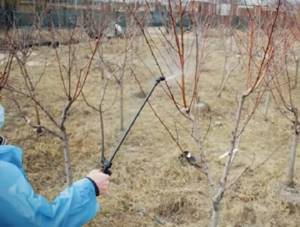
When pruning and cleaning trees and shrubs, tops, frostbitten and dead branches are removed, and the dense crown is cleared. In this case, it is necessary to treat areas of the bark affected by rodents, that is, strip them down to living wood and treat them with 1% copper sulfate, then with a product such as RanNet. They also use it to treat areas on cut branches. Exfoliated and dead bark and that which is cracked are removed and burned; they are not left under the tree.
Important! When carrying out preventive work, it is recommended to spread film or other bedding under the crown. After completion of the work, all waste is collected and burned. Stumps affected by fungi should be uprooted and burned.
If there are hollows on the trees, they are cleaned, disinfected, lubricated and allowed to dry, covering them from dirt and rain. The trunks and trunk branches are covered with whitewash. This will stop the development of larvae that have remained since the fall, repel adult insects and kill fungal spores. For whitewashing, store-bought products in aerosols, acrylic or water-dispersed, permeable to air, ready-made with fungicides, are used.
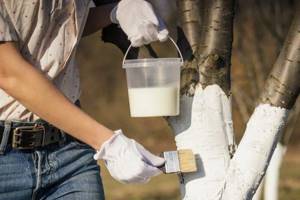
You can prepare whitewash yourself as follows:
- stir slaked lime (2 kg) in water (10 l);
- add clay (1 kg) and copper sulfate (250 g) to the bucket;
- You can add glue and laundry soap.
Be sure to treat tree trunk areas after collecting last year's leaves and mummified fruits. They are burned off site.
The first spraying is carried out generously from the surface of the crown and gradually moves towards the trunk from top to bottom, then the surrounding circles are treated. They are then covered with black film and removed after the flowering phase is completed. This will reduce the release of larvae of harmful insects from the soil. After treatment, insect catching belts should be worn on tree trunks.
Shrubs: currants and gooseberries, black rowan are processed after the snow melts. At the first signs of American powdery mildew on gooseberries, cut out damaged branches. If there are unnaturally swollen buds on the currant, the branches are cut off and destroyed outside the garden, since female mites will settle in the buds. For spraying you will need iron sulfate or Nitrafen.
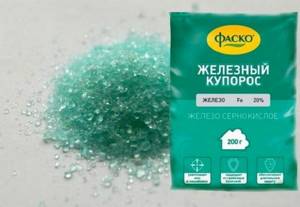
Second spray
Along the green cone, or when life emerges in the buds after the winter cold, to prevent the invasion of pests and outbreaks of diseases that occurred last season, a second treatment with chemical or biological preparations is carried out. They are selected depending on the disease and type of pest. It must be taken into account that chemistry has side effects and worsens the environment. Biological agents are less aggressive and do not pose a danger to beneficial living organisms: insects, animals and people. The drugs are based on the cells of living aggressive microorganisms: antagonist fungi, bacterial viruses and bacteria. From the lists given below, you can choose what to spray fruit trees and shrubs with in the spring.
The most commonly used chemicals are:
- Bordeaux liquid . It is a broad spectrum fungicide.
- Fufanon. A broad-spectrum insecticide kills mites and leaf rollers, weevils, scale insects, crimson beetles, aphids, moths, moths, and thrips.
- Decis. This contact-intestinal insecticide destroys the following pests: Coleoptera, Lepidoptera, Homoptera.
- Inta-Vir. An enteric-contact insecticide kills aphids, leaf-eating caterpillars, thrips, and whiteflies.
- Akarin. A wide-spectrum insecticide destroys leaf rollers, moths, sawflies, aphids, mites, and garden pests.
- Bi-58. The insectoaccaricide drug harms mites and scale insects, leaf rollers, codling moths, copperheads, moths, and root pests.
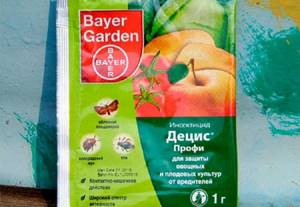
Among the biological products in demand are:
- Lepidocide. Can be sprayed when sawflies invade fruit and berry crops, deciduous and coniferous trees.
- BTB-202 (Bitoxibacillin). It has the same effect as Lepidocide and kills spider mites.
- Gaupsin . Destroys fungus, mites, moths, leaf rollers, aphids.
- Fitoverm . You can spray against mites, codling moths, aphids (various), apple moths, sawflies, thrips, leaf rollers.
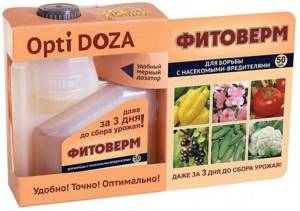
Third spray
You can spray trees and shrubs during flowering with biological products that stimulate the formation of ovaries. This is relevant in weather that is not conducive to the flight of bees. The growth stimulator is the drug “Ovary” or “Universal Ovary”. Trees are first treated during active flowering and 7-10 days later during the fruiting phase.
Note! Berry gardens are treated at the beginning of the budding phase and later during the development of the ovary. At this time, you can fill the hollows in the trees after cleaning and disinfection.
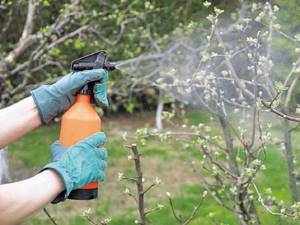
Fourth spray
As soon as the plants fade and the fruit formation phase begins, harmful insects begin to create voracious offspring. There is no time to waste; pests must be destroyed. At this time, the following plants are affected:
- Apricots. They get sick with clasterosporiasis and monial burn. What to spray with: a solution of copper sulfate (1%) or copper oxychloride, and an insecticide is added to these products against leaf rollers.
- Plums. They get sick with moniliosis, clasterosporiasis, and polystigmosis. What to spray: copper oxychloride and add insecticide if necessary.
- Cherries and cherries. The leaves are affected by clasterosporiosis, coccomycosis, aphids, leaf rollers, and cherry flies. Fungi are destroyed with copper oxychloride and Topsin, insects with Zolon and Sumition.
- Pears and apple trees. Powdery mildew, scab, and other spots on the leaves appear on them. Fungicides used for treatment: Vectru, Rubigan, Skor, Strobi. Repeat the treatment after 2 weeks, but with any other drug.
If sawfly, mites, aphids, leaf rollers and other pests appear after the flowering phase, then treatment is again carried out using insecticides with a wide range of effects: Danadima, Mitaka, BI 58N, Rogora S.
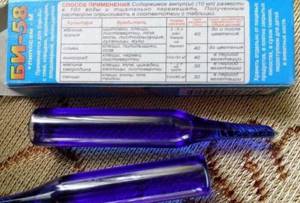
Garden care after treatment
After spraying, it is advisable not to disturb the garden plantings for several days so that the active substance has time to be absorbed into the bark. Then you can continue pre-winter preparation. The trunks and lower skeletal branches must be whitened with lime mortar, if this has not been done previously. This will protect them from frost damage and sunburn.

To protect against rodents, install protective grilles, stretch the mesh, or wrap the trunks with spruce branches.
Step-by-step preparation of plants for wintering
Before you treat trees and shrubs in the fall against pests and diseases, you need to know that this procedure includes 5 mandatory steps.
Interesting!
During the period when the trees form inflorescences and bear fruit, they absolutely do not need treatment, even watering is significantly reduced; it is only recommended to fertilize with nutrients and microelements.

List of step-by-step actions for harvest processing:
- Collect trash. This means fallen leaves; they need to be collected and burned, because they are an excellent place for overwintering insect pests.
- Dig up the area and apply fertilizer. The soil should be dug up a quarter of a meter around the trunk, and caterpillars, larvae and weeds must be removed. A prerequisite is the weather without precipitation. If the question arises of how to treat trees and shrubs in the fall against pests and diseases, then complex fertilizers are perfect for this event. Moreover, they can be individual for each plant. But often they contain superphosphate, peat or humus and potassium sulfate. Fertilizers are simply poured around the trunk and spilled with 5-6 liters of water.
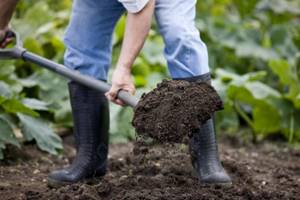
- Crown treatment. Insecticides and fungicides are what to treat fruit and berry trees and shrubs against pests and diseases in the fall.
- Removal of damaged and diseased branches. Various shrubs and trees require individual care and approach. Therefore, before you start pruning, you should study the diagram in detail so as not to harm the plant.
- Cleaning the bark and whitewashing the trunk. A very important nuance: before treating trees and shrubs in the fall against pests and diseases, the old bark should be cleaned of loose scales. In this case, a chisel with a sharpened edge will come in handy. Codling moths and other caterpillars overwinter and live under the old bark, laying eggs in it. After the procedure, you need to whiten the trunk with a special compound. Ideal for this would be: clay, slaked lime, fresh mullein or lime. You can also use wood ash. It is best to repeat the whitewashing procedure in the spring, before fruit and berry crops begin to bloom.
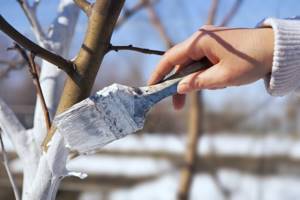
- Adding mulch. These are rotted leaves, pine paws, sawdust, peat. This is a kind of “scarf” for the tree that will protect the rhizomes from severe frosts, so the mulch layer should be at least 15-20 cm.
- Warming for the winter. Trees and shrubs, just like people, need warmth in winter. For these purposes, a wide variety of materials and plants are used, for example, fabric, roofing felt, sunflower, cinquefoil, cattail. The best insulation option is to cover the tree trunk with a metal mesh and warm fabric on top. This simple structure will not only protect the plant from frost, but will also prevent the branches and trunk from breaking in the event of strong gusts of wind.
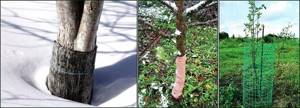
For reference!
You can start processing plants in the garden a week after harvesting.
All stages must be completed on time and without fail, only then will fruit trees and shrubs be able to please their owners with a harvest for the next season.
